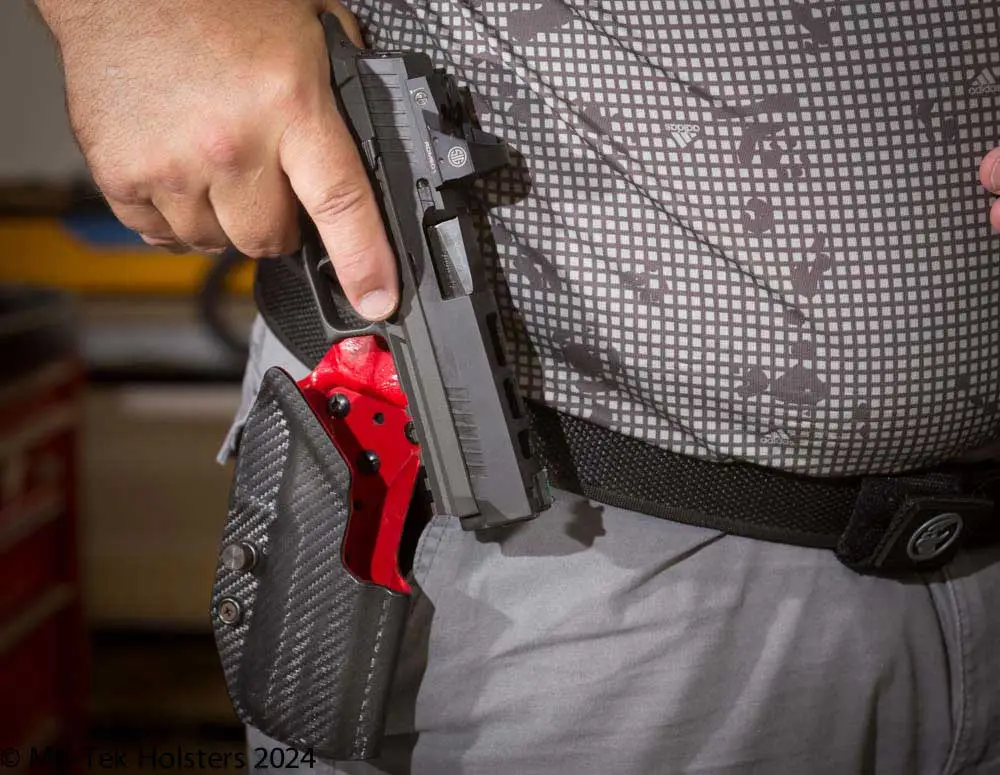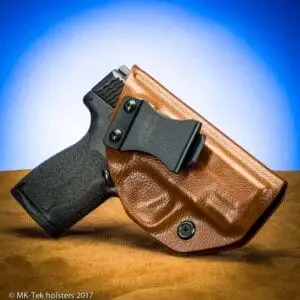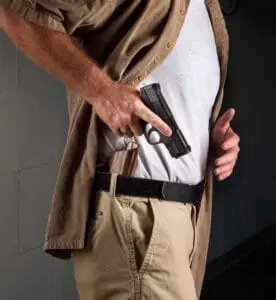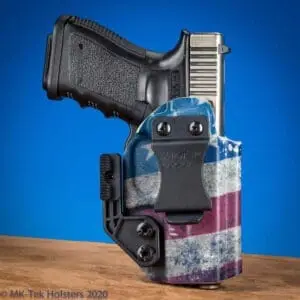Mastering Pistol Trigger Control in High-Stress Environments
If you’ve ever tried firing a pistol in a controlled environment, you know that trigger control is a fundamental skill. But maintaining that same precision in a high-stress situation? That’s a different ballgame. In the real world, when adrenaline is pumping and every second counts, your ability to control the trigger can be the difference between a hit or miss—or something far more significant.
At MK-Tek Holsters, we’re all about equipping responsible firearm carriers with the right tools and knowledge. Concealed Carry Essentials is a post on our Blog. Here, we break down the basics of trigger control under stress and how to build the skills that keep you steady when it matters most.
Why Trigger Control is Harder Under Stress
Stress, especially life-threatening stress, changes everything about the way your body operates. In these situations, the body’s natural response kicks in, and you’ll likely experience:
- Increased Heart Rate: In a high-stress scenario, your heart rate can quickly jump above 115 beats per minute, which affects your motor control.
- Loss of Fine Motor Skills: Under stress, we tend to lose fine motor skills in favor of gross motor skills. Trigger control is all about fine motor skills, which means stress directly affects your ability to shoot accurately.
- Tunnel Vision: In a fight-or-flight situation, you may experience tunnel vision, auditory exclusion, and even a distorted sense of time.
For shooters, these physical responses can mean gripping the gun too tightly, jerking the trigger, or pulling off-target. The goal is to train yourself to remain steady, so you can manage these physical effects and maintain accuracy even in the heat of the moment.
Building Trigger Control for Real-World Scenarios
Practicing at the range is one thing, but preparing for high-stress situations takes additional mental and physical training. Here’s how to get started.
1. Train to Reduce Anticipation
In high-stress situations, people tend to “anticipate” the shot. This anticipation can lead to jerking the trigger or flinching, which can throw the shot off target. To combat this, focus on the following:
- Surprise Break: Try to make the trigger break a surprise. Start by practicing at a slower pace until you can pull the trigger without anticipating the exact moment the gun will fire.
- Dry-Fire Practice: With an unloaded gun, practice dry-firing to get used to the trigger’s travel and feel. This practice reinforces muscle memory and helps eliminate anticipation. Many firearm trainers recommend dry-firing as it builds familiarity with your firearm and enhances your control without live rounds.
2. Use Progressive Drills to Introduce Stress
It’s essential to incorporate stress into your training because firing at a target in a calm state doesn’t prepare you for real-world conditions. Here are a few ways to add a layer of stress to your trigger control training:
- Physical Drills: Add movement or light exercise before shooting. A few quick sprints or push-ups can elevate your heart rate to simulate stress and test your control when your pulse is elevated.
- Timed Drills: Set a timer and try to complete drills under a strict time limit. The ticking clock adds a layer of mental pressure and helps you get comfortable performing under stress.
- Participate to local matches that emphasizes practical shooting like IDPA or USPSA.
Studies show that even modest physical exercise increases heart rate enough to impair fine motor skills, which makes these drills great for building control under pressure. Pistol Trigger Control in High-Stress Environments will determine the outcome.
3. Focus on a Smooth Trigger Pull
When you’re in a tense situation, you may be tempted to yank the trigger to rush the shot. But that sudden pull will throw off your aim. Instead, train yourself to use a smooth, consistent trigger pull. Think of it as pressing rather than pulling—apply steady pressure on the trigger until the shot breaks.
At MK-Tek Holsters, we often recommend trigger control practice that prioritizes smooth, controlled pressure over speed, especially in the beginning. Start by aiming to feel each stage of the trigger as you pull it back, noticing any resistance and learning to apply steady, consistent force.
4. Mental Training: Practice Staying Calm
In high-stress situations, staying calm is as important as having physical control. Practicing mindfulness and breathing exercises can help you stay focused and calm under pressure.
- Controlled Breathing: Simple breathing exercises, like the 4-4-4-4 method (inhale for 4 seconds, hold for 4, exhale for 4, hold for 4), can help slow your heart rate and regain control. Practicing this regularly can make it easier to control your breathing under stress.
- Visualization: Visualize yourself succeeding in high-stress scenarios. Picture yourself handling the situation calmly and executing each step correctly. This kind of mental preparation reinforces a positive outcome and can give you more confidence in real-world situations.
5. Don’t Skip the Basics: Get the Right Gear
Having the right gear is essential to ensuring your trigger control techniques hold up in real scenarios. An ill-fitting holster, for example, can make it harder to draw and reacquire the target efficiently. MK-Tek Holsters offers custom-fitted Boltaron or Kydex holsters that provide easy access and solid retention, allowing you to focus on the fundamentals rather than fumbling with your gear.
Plus, our holsters are designed with trigger protection in mind, so you can confidently handle your firearm knowing that it’s safe and secure until you’re ready to shoot.
Why Trigger Control Training is Worth It
There’s a lot to think about when it comes to firearm accuracy, but trigger control under stress is one of the most critical skills you can develop. A study from the Force Science Institute found that officers and civilians who practiced stress-based shooting had significantly higher hit rates in real-life encounters. This skill directly translates to better control, increased confidence, and better outcomes.
Final Thoughts: Consistent Practice is Key
Improving your trigger control under stress isn’t a one-time thing—it’s about building muscle memory and reinforcing good habits. Incorporate stress-inducing drills, keep up your practice, and use the right gear that complements your training efforts. With patience, consistency, and proper training, you’ll be better prepared to handle your firearm confidently and accurately in any situation.
Remember, the goal is to make trigger control instinctual so that even when adrenaline is at its peak, you’re ready. And when it comes to your holster needs, MK-Tek Holsters is here to support you with high-quality options designed to work seamlessly in high-pressure situations.





